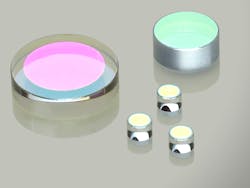A series of negative group delay dispersion mirrors is available for use with industrial ultrafast lasers with visible or NIR output. They deliver GDD values as high as -5000 fs2 (with an accuracy ±10%) at the specific laser wavelength, while also offering reflectivity >99.8% and high laser-damage threshold. They are typically on silica substrates.
REO
Boulder, CO
www.reoinc.com
More Products
-----
PRESS RELEASE
New Negative Dispersion Mirrors for Ultrafast Lasers
REO, a leading manufacturer of high volume precision optical solutions, has introduced a new series of negative Group Delay Dispersion (GDD) mirrors for use with industrial ultrafast lasers having output in the visible or near infrared spectrum. These mirrors can be designed to deliver GDD values as high as -5000 fs² (with an accuracy ±10%) at the specific laser wavelength, while also offering excellent reflectivity (>99.8%) as well as high laser damage threshold. Together, these characteristics make these mirrors ideal for intra-cavity use in order to balance out self-phase modulation, and correct for the residual net dispersion due to other components in the laser cavity, including mirrors, windows and crystals. They are also well-suited for use in extra-cavity applications, such as for turning mirrors and in pulse compression systems.
Producing GDD correction optics requires thin film coating with a high degree of precision and repeatability in terms of layer thickness and refractive index, deposited on to extremely low scatter optical surfaces. REO employs our own enhanced superpolishing techniques to routinely achieve microroughness levels below 0.5 Å, resulting in a scattering loss of less than 5 ppm. These substrates are coated using ion beam sputtering (IBS) equipped with REO’s proprietary deposition monitoring technology to yield unsurpassed layer precision and low absorption.
REO negative GDD mirrors are typically supplied on fused silica substrates, in diameters of up to 3 inches, with a flatness of λ/20 (at 633 nm), a surface quality of 10-5 over an 80% clear aperture, and zero defects (0-0) achievable over controlled sub-apertures. Nominal incidence angles anywhere in the 0° to 45° range can be accommodated. REO can also produce GDD compensating mirrors with a wide range of specifications on a custom basis.
About REO
REO produces high precision thin film coatings, optics and opto-mechanical assemblies for the ultraviolet, visible and infrared. Located in Boulder, CO, the company primarily services medium to high volume OEMs including manufacturers of defense and aerospace systems, laser systems, semiconductor tools, medical systems, life sciences instrumentation and telecom equipment. REO is a privately held company. For more information, contact Trey Turner, Chief Technology Officer, at +1-303-245-4390, e mail [email protected], www.reoinc.com, or Susan Anway, Vice President of Finance and Chief Financial Officer at +1-720-562-3206, e-mail [email protected].
-----
Follow us on Twitter
Subscribe now to Laser Focus World magazine; it's free!
